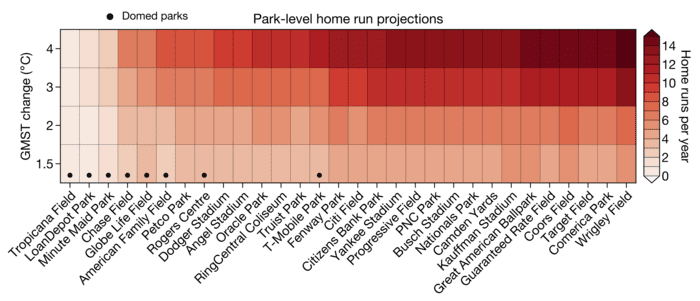Rising temperatures are tilting the playing field very slightly in favor of batters and against pitchers in Major League Baseball, a new study finds. Although the difference global heating is making is currently small, by the end of the century it could be creating a major distortion, comparable to the steroids era and the 1920 shift to a livelier ball.
Comparing modern sporting heroes with the giants of the past is a favorite pastime of sports fans. It’s particularly tempting in a statistics-heavy sport like baseball. When something changes between eras, such as the rise in home runs since 1980, it throws such comparisons off and creates a demand for answers.
Dartmouth PhD student Christopher Callahan was intrigued by this trend. Everything from steroid use to improved analytics on pitchers has been blamed, but as a geography student Callahan was aware how often climate change is an amplifying factor. In a new paper, Callahan and co-authors provide evidence a small proportion of the increase can be attributed to higher temperatures. Moreover, this is set to increase to the point where comparisons between eras, at least on this measure, may become almost meaningless.
“There’s a very clear physical mechanism at play in which warmer temperatures reduce the density of air,” said senior author Dr Justin Mankin in a statement. “Baseball is a game of ballistics, and a batted ball is going to fly farther on a warm day.”
The difference is small, and might easily be overwhelmed by other factors, such as whether standing beneath the beating Sun might sap a batter’s strength. To test the idea would require a vast sample size; fortunately, baseball has that in abundance.
Using data from more than 100,000 Major League games, Callahan tried to tease out the effect of temperature from other factors such as performance-enhancing drugs, equipment changes, and new training techniques.
“We asked whether there are more home runs on unseasonably warm days than on unseasonably cold days during the course of a season,” Callahan said. “We’re able to compare those days with the implicit assumption that the other factors affecting batter performance don’t vary day to day.”
“We don’t think temperature is the dominant factor in the increase in home runs – batters are now primed to hit balls at optimal speeds and angles,” Callahan added. Nevertheless, the authors concluded that since 2010, higher temperatures across North America have led to more than 500 additional home runs. That’s only about 1 percent of the extra number scored in that time, but the figure could rise to 10 percent without action to curb fossil fuel consumption.
The authors went further and predicted the number of extra home runs by ballpark, noting that indoor stadiums such as Tropicana Field will be unaffected, other than needing to spend more on air conditioning. Wrigley Field is anticipated to have the greatest heat-induced increase at 15 extra home runs a year.
A comparison of how many extra home runs can be expected at different baseball fields depending how much global temperatures rise. Image credit: Christopher Callahan
Anyone unwilling to limit their greenhouse emissions to save low-lying cities or endangered species is unlikely to change their mind because of a few extra homers; they may even welcome them. Players collapsing from heat stroke, however, might prove more of a wake-up call.
Such concerns aren’t limited to baseball, and athletes from hotter countries are particularly alarmed. Australian professional cricketers are donating money so their first club can install solar panels, and refusing to appear in ads for fossil fuel companies sponsoring their teams. Perhaps climate activists should target baseball pitchers as allies.
The use of baseball’s abundant statistics to make a scientific point has a fine tradition. Stephen Jay Gould used evolutionary principles to explain the extinction of batters with .400 averages. As in Callahan’s research, the question under consideration was more interesting than important, but both authors drew on the richness of data that Major League Baseball provides to illuminate something much broader.
The study is published in the Bulletin of the American Meteorological Society.
Source Link: Global Warming Is Already Disrupting Major League Baseball Statistics
